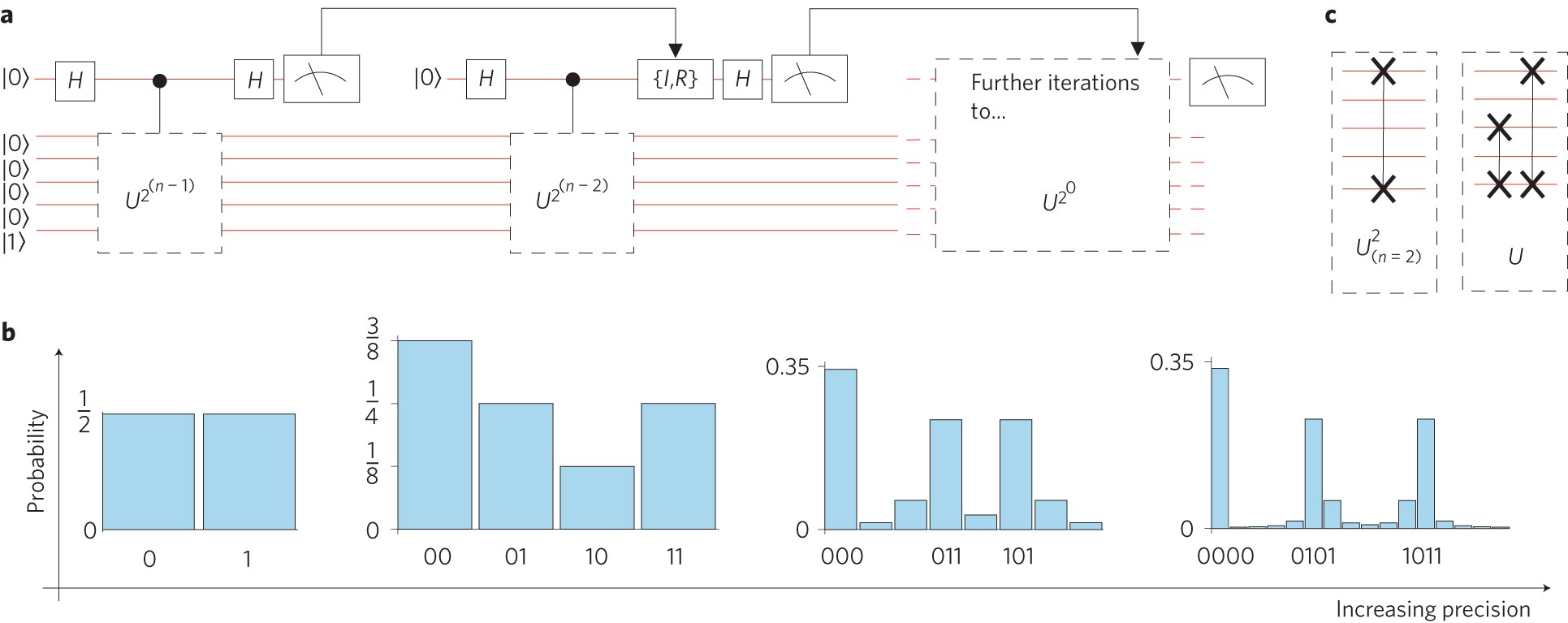www.nature.com/nphoton/journal/v6/n11/full/nphoton.2012.259.html
Preview meta tags from the www.nature.com website.
Linked Hostnames
29- 70 links towww.nature.com
- 27 links todoi.org
- 25 links toscholar.google.com
- 21 links toadsabs.harvard.edu
- 8 links towww.springernature.com
- 6 links toscholar.google.co.uk
- 6 links towww.ncbi.nlm.nih.gov
- 4 links topartnerships.nature.com
Thumbnail

Search Engine Appearance
Experimental realization of Shor's quantum factoring algorithm using qubit recycling - Nature Photonics
Quantum computational algorithms exploit quantum mechanics to solve problems exponentially faster than the best classical algorithms1,2,3. Shor's quantum algorithm4 for fast number factoring is a key example and the prime motivator in the international effort to realize a quantum computer5. However, due to the substantial resource requirement, to date there have been only four small-scale demonstrations6,7,8,9. Here, we address this resource demand and demonstrate a scalable version of Shor's algorithm in which the n-qubit control register is replaced by a single qubit that is recycled n times: the total number of qubits is one-third of that required in the standard protocol10,11. Encoding the work register in higher-dimensional states, we implement a two-photon compiled algorithm to factor N = 21. The algorithmic output is distinguishable from noise, in contrast to previous demonstrations. These results point to larger-scale implementations of Shor's algorithm by harnessing scalable resource reductions applicable to all physical architectures. By using qubit recycling, researchers demonstrate a scalable version of Shor's algorithm in which the total number of qubits is one third of that required in the standard protocol. They experimentally implemented a two-photon compiled algorithm to factor N = 21, pointing to larger-scale implementations of Shor's algorithm.
Bing
Experimental realization of Shor's quantum factoring algorithm using qubit recycling - Nature Photonics
Quantum computational algorithms exploit quantum mechanics to solve problems exponentially faster than the best classical algorithms1,2,3. Shor's quantum algorithm4 for fast number factoring is a key example and the prime motivator in the international effort to realize a quantum computer5. However, due to the substantial resource requirement, to date there have been only four small-scale demonstrations6,7,8,9. Here, we address this resource demand and demonstrate a scalable version of Shor's algorithm in which the n-qubit control register is replaced by a single qubit that is recycled n times: the total number of qubits is one-third of that required in the standard protocol10,11. Encoding the work register in higher-dimensional states, we implement a two-photon compiled algorithm to factor N = 21. The algorithmic output is distinguishable from noise, in contrast to previous demonstrations. These results point to larger-scale implementations of Shor's algorithm by harnessing scalable resource reductions applicable to all physical architectures. By using qubit recycling, researchers demonstrate a scalable version of Shor's algorithm in which the total number of qubits is one third of that required in the standard protocol. They experimentally implemented a two-photon compiled algorithm to factor N = 21, pointing to larger-scale implementations of Shor's algorithm.
DuckDuckGo
Experimental realization of Shor's quantum factoring algorithm using qubit recycling - Nature Photonics
Quantum computational algorithms exploit quantum mechanics to solve problems exponentially faster than the best classical algorithms1,2,3. Shor's quantum algorithm4 for fast number factoring is a key example and the prime motivator in the international effort to realize a quantum computer5. However, due to the substantial resource requirement, to date there have been only four small-scale demonstrations6,7,8,9. Here, we address this resource demand and demonstrate a scalable version of Shor's algorithm in which the n-qubit control register is replaced by a single qubit that is recycled n times: the total number of qubits is one-third of that required in the standard protocol10,11. Encoding the work register in higher-dimensional states, we implement a two-photon compiled algorithm to factor N = 21. The algorithmic output is distinguishable from noise, in contrast to previous demonstrations. These results point to larger-scale implementations of Shor's algorithm by harnessing scalable resource reductions applicable to all physical architectures. By using qubit recycling, researchers demonstrate a scalable version of Shor's algorithm in which the total number of qubits is one third of that required in the standard protocol. They experimentally implemented a two-photon compiled algorithm to factor N = 21, pointing to larger-scale implementations of Shor's algorithm.
General Meta Tags
105- titleExperimental realization of Shor's quantum factoring algorithm using qubit recycling | Nature Photonics
- titleClose banner
- titleClose banner
- X-UA-CompatibleIE=edge
- applicable-devicepc,mobile
Open Graph Meta Tags
6- og:urlhttps://www.nature.com/articles/nphoton.2012.259
- og:typearticle
- og:site_nameNature
- og:titleExperimental realization of Shor's quantum factoring algorithm using qubit recycling - Nature Photonics
- og:descriptionBy using qubit recycling, researchers demonstrate a scalable version of Shor's algorithm in which the total number of qubits is one third of that required in the standard protocol. They experimentally implemented a two-photon compiled algorithm to factor N = 21, pointing to larger-scale implementations of Shor's algorithm.
Twitter Meta Tags
6- twitter:site@NaturePhotonics
- twitter:cardsummary_large_image
- twitter:image:altContent cover image
- twitter:titleExperimental realization of Shor's quantum factoring algorithm using qubit recycling
- twitter:descriptionNature Photonics - By using qubit recycling, researchers demonstrate a scalable version of Shor's algorithm in which the total number of qubits is one third of that required in the standard...
Item Prop Meta Tags
5- position1
- position2
- position3
- position4
- publisherSpringer Nature
Link Tags
15- alternatehttps://www.nature.com/nphoton.rss
- apple-touch-icon/static/images/favicons/nature/apple-touch-icon-f39cb19454.png
- canonicalhttps://www.nature.com/articles/nphoton.2012.259
- icon/static/images/favicons/nature/favicon-48x48-b52890008c.png
- icon/static/images/favicons/nature/favicon-32x32-3fe59ece92.png
Emails
1Links
197- http://adsabs.harvard.edu/cgi-bin/nph-data_query?link_type=ABSTRACT&bibcode=1985RSPSA.400...97D
- http://adsabs.harvard.edu/cgi-bin/nph-data_query?link_type=ABSTRACT&bibcode=1996PhRvA..54.1034B
- http://adsabs.harvard.edu/cgi-bin/nph-data_query?link_type=ABSTRACT&bibcode=1996PhRvL..76.3228G
- http://adsabs.harvard.edu/cgi-bin/nph-data_query?link_type=ABSTRACT&bibcode=1999PhRvA..60..773K
- http://adsabs.harvard.edu/cgi-bin/nph-data_query?link_type=ABSTRACT&bibcode=2000PhRvL..85.3049P